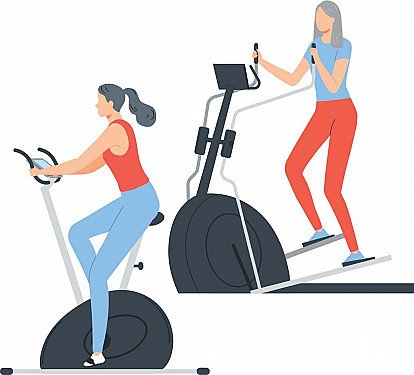Resistance training by the numbers
How much weight, how many reps and sets, and how often? Here's what new guidelines suggest.

Old-fashioned resistance training — lifting heavy weights multiple times — is the best way for men to slow and even reverse age-related muscle loss, known as sarcopenia. It can also increase your strength, protect against falls, and help you live a more independent life.
Resistance training (also known as strength training) consists of doing upper- and lower-body exercises using free weights (like dumbbells, kettlebells, or barbells), weight machines, resistance bands, or just your own body weight.
The constant challenge with resistance training is finding the Goldilocks zone between doing too little and too much.
"The goal is to stress your muscles enough to see and feel a difference, but not overdo it, where you risk injury," says Keelin Godsey, a physical therapist with Harvard-affiliated Spaulding Rehabilitation Network. "You also want to train with a goal of continuous improvement, not plateau."
How do you locate that happy medium? It comes down to five categories: type, weight, reps, sets, and frequency.
Get a helping handIf possible, see a certified trainer before you embark on a resistance training program. "It's worth the time and investment, as he or she can create a routine unique to your needs, and most important, teach you proper form and speed," says Keelin Godsey, a physical therapist with Harvard-affiliated Spaulding Rehabilitation Network. A trainer can also show you different exercises for each muscle group so you can mix and match your workouts for variety. "This helps you not get bored with your workouts," says Godsey. "Once you know the basics, then you can easily and safely work out on your own." |
Give workouts a lift
There are many theories about the ideal approach to resistance training. Guidelines published in the August 2019 issue of The Journal of Strength and Conditioning Research offer some strong evidence-based advice. Researchers reviewed years of exercise data and determined that the following criteria for the five categories are ideal for older adults.
Type. The guidelines suggest one to two multi-joint exercises per major muscle group. There are six main muscle groups: chest, back, arms, shoulders, legs, and calves. So this means six to 12 exercises per workout.
As its name implies, multi-joint exercises are movements that engage more than one joint at a time — for example, elbow and shoulder, or knee and ankle. This is different from single-joint exercises that focus on isolated muscles, like a biceps curl.
"There's nothing wrong with single-joint exercises, and they're often the ones people are most familiar with. But with multi-joint exercises, you can train with heavier weights, which helps to increase muscle mass faster," says Godsey.
Weight. Older adults should aim to exercise with weight at 70% to 85% of their maximum one rep. Maximum one rep is the amount of weight you can lift just once. "You can still receive benefits from lifting lighter weight and less resistance, but the 70%-to-85% range is better," says Godsey.
However, determining a maximum one rep can be difficult for many older adults, as they can hurt themselves if they try lifting too heavy a weight without proper training and support. A simpler, safer approach is to use enough weight or resistance so you can perform 10 reps with good form. "The last two should be tough to complete, and you should have no more than one or two extra reps in reserve," says Godsey.
You can adjust the weight of your dumbbells or kettlebells as needed to find this sweet spot. For resistance bands, you need to change the tautness to make it more or less difficult to move. For body-weight movements, like a push-up, use the same approach: Decrease the resistance if it's too tough — for instance, by doing the push-up from your knees or against a counter. To increase the resistance, elevate your feet, or shift your hands inward from beneath your shoulders.
Reps. The guideline found that anywhere from six to 12 reps per exercise were beneficial. Godsey suggests beginning with 10 reps at light to medium resistance. "This is about in the middle of this range and is an easy number to remember," he says. "But as you progress, you should aim for six to eight reps with increased weight or resistance."
Sets. The guidelines recommend two to three sets per exercise. Godsey suggests beginning with two sets at first. "Always rest in between for anywhere from 30 seconds to two minutes, if needed, to help you recover," he says.
Frequency. More is not always better when it comes to resistance training. Two or three workouts per week produces the most muscle size and strength compared with fewer or more sessions. "Begin with twice a week, spread out by a few days, and then add another workout as you progress," says Godsey.
Keep in mind that it can take time to see increased muscle mass and feel stronger. "Consistency is essential, but if you don't notice changes after about eight weeks, you are not training hard enough and need to mix up your routine by increasing your weight or sets or the number of exercises," says Godsey.
Image: © LattaPictures/Getty Images
Disclaimer:
As a service to our readers, Harvard Health Publishing provides access to our library of archived content. Please note the date of last review or update on all articles.
No content on this site, regardless of date, should ever be used as a substitute for direct medical advice from your doctor or other qualified clinician.
















